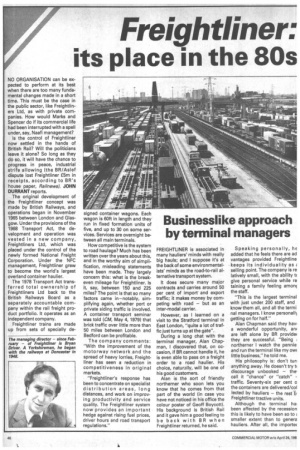Freightliner:
Page 40

If you've noticed an error in this article please click here to report it so we can fix it.
its place in the 80s
NO ORGANISATION can be expected to perform at its best when there are too many fundamental changes made in a short time. This must be the case in the public sector, like Freightliners Ltd, as with private companies. How would Marks and Spencer do if its commercial life had been interrupted with a spell under, say, Naafi management?
Is the control of Freightliner now settled in the hands of British Rail? Will the politicians leave it alone? So long as they do so, it will have the chance to progress in peace, industrial strife allowing (the BR/Aslef dispute lost Freightliner £5m in receipts, according to BR's house paper, Raiinews), JOHN DURRANT reports.
The original development of the Freightliner concept was made by British Railways, and operations began in November 1965 between London and Glasgow. Under the provisions of the 1968 Transport Act, the development and operation was vested in a new company, Freightliners Ltd, which was placed under the control of the newly formed National Freight Corporation. Under the NFC management, Freightliner grew to become the world's largest overland container haulier.
The 1978 Transport Act transferred total ownership of Freightliners Ltd back to the British Railways Board as a separately accountable company within the rail freight product portfolio. It operates as an independent company.
Freightliner trains are made up from sets of specially de
signed container wagons. Each wagon is 60ft in length and they run in fixed formation units of five, and up to 30 on some services. Services are overnight between all main terminals.
How competitive is the system to road haulage? Much has been written over the years about this, and in the worthy aim of simplification, misleading statements have been made. They largely concern this: what is the breakeven mileage for Freightliner. Is it, say, between 150 and 225 miles? The point is that so many factors came in—notably, simplifying again, whether port or private siding traffic is involved. A container transport seminar was told (CM, May 4, 1979) that brick traffic over little more than 50 miles between London and Bedford can be profitable.
The company comments: "With the improvement of the motorway network and the spread of heavy lorries, Freightliner has seen a reduction in competitiveness in original markets.
"Freightliner's response has been to concentrate on specialist distribution areas, long distances, and work on improving productivity and service quality. The Freightliner system now provides an important hedge against rising fuel prices, driver hours and road transport regulations."


























































